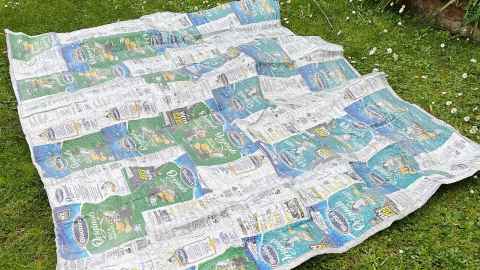Wrapping the homeless in chip packets no blanket solution
14 September 2023
Opinion: Diane Brand reflects New Zealand has come to, land of phenomenal wealth for a few and a large proportion of our population homeless, being kept warm with repurposed chip bags.

I volunteer for the Chip Packet Project New Zealand where I have learned more about the dire housing predicament of a significant section of our local community, especially in Auckland.
The project was founded by Terrena Griffiths in 2021 and is based on a similar organisation in the United Kingdom. It gives direct assistance to whānau struggling with homelessness and unhealthy homes, using volunteer labour and rubbish from foil packaging. Discarded chip packets are reused as blankets, bags, pillows, and ground sheets. The blankets, with shiny sides facing in, act like emergency blankets where the user’s body heat is reflected to help keep them warm and dry in cold or damp conditions.
Typically, a volunteer fabricates a five-by-five grid of washed and opened-out packets by fusing them together using a domestic iron set on ‘silk’ to get a smooth bond and ironing the seams using a piece of baking paper to avoid direct heat on the packet’s plastic surface. The blanket is then encapsulated in a lighter plastic (pallet wrapping donated by Mitre 10) and fused again to make the item robust. Finally, the edges are folded and fused to complete the process. The blankets can last on the streets for 10 years.
According to the 2018 census, Māori make up 43 percent of homeless people in Auckland, despite making up only 16 percent of the population. For Pacific peoples the figure is 18 percent. This means 61 percent of the homeless are Māori or Pacific.
These emergency blankets can also be used in natural disasters where communities and homes have been devastated by extreme weather events or seismic activity. The Chip Packet Project has provided 302 blankets to people since 2022. Blankets are distributed to the homeless via charities and to those living in substandard accommodation via kindergartens in the poorer parts of Auckland, where children are living in unheated homes, garages, or cars and cannot sleep because they are freezing in winter. The project provides direct relief to those suffering homelessness and housing degradation by ensuring people can stay warm.
Schools around the country act as collection points for used foil packaging and these are then washed and delivered to a Chip Packet Project centre where more than 85 volunteers nationally participate in the manual manufacture of the blankets and accessories. This is extremely labour intensive, and each blanket takes about four hours to make. The organisation also collaborates with the New Zealand Corrections Department, where prisoners can do their community service by making blankets. Scouts New Zealand also takes part.
This is what New Zealand has come to – a land of phenomenal wealth for a few, in which an alarmingly large proportion of our population is homeless, kept warm with repurposed chip bags made by volunteers. Though all demographics are affected by our housing crisis, Māori and young people are overrepresented, with 62 percent of the homeless aged between 21 and 40. According to the 2018 census, Māori make up 43 percent of homeless people in Auckland, despite making up only 16 percent of the population. For Pacific peoples the figure is 18 percent. This means 61 percent of the homeless are Māori or Pacific.
In Northland, homelessness for Māori increased tenfold between 2018 and 2021 (Northland District Health Board). Many more Māori and Pacific people live in substandard accommodation in both regions. This homelessness is a national shame. Māori and Pacific homelessness perpetrate long-established inequities resulting from colonisation in the region. This data is from the 2018 census, and evidence suggests the problem has got worse since then. The Ministry of Social Development estimates 69,000 people across the country need assistance because of homelessness. There is demand for more than 2200 blankets, a volume that current volunteers fall short of meeting.
Discarded chip packets are the result of junk food consumerism, and they add significantly to landfill waste. They take 80 years to break down in landfill, the chips have little nutritional value and contribute to poor health. The Chip Packet Project transforms these negatives to make a positive community contribution, and a climate change initiative, by clever design and volunteer participation. The activity creates a community of makers for people seeking to join a group or contribute to a worthy cause. In practical terms homeless people are warmer and are perhaps conscious that someone cares enough to make these items to help alleviate one aspect of the hardship of living on the streets.
The demand for affordable housing is urgent but the need for shelter, warmth, and care for the homeless is acute. It’s time for politicians of all stripes to front up and begin to fix a situation decades in the making and involves former National and Labour governments. Policies as diverse as the sale of state housing, and the defunding of medical care, mental health, law and order, and education are the harbingers of this crisis.
While politicians contest our votes and disappoint on policy delivery, volunteer groups will continue to chip away at the challenge one foil packet at a time.

Professor Diane Brand is an architect and urban designer, Director of Academic Reviews, and former Dean of Creative Arts and Industries.
This article reflects the opinion of the author and not necessarily the views of Waipapa Taumata Rau University of Auckland.
This article was first published on Newsroom, Wrapping the homeless in chip packets is hardly a blanket solution, 14 September, 2023
Media contact
Margo White I Research communications editor
Mob 021 926 408
Email margo.white@auckland.ac.nz